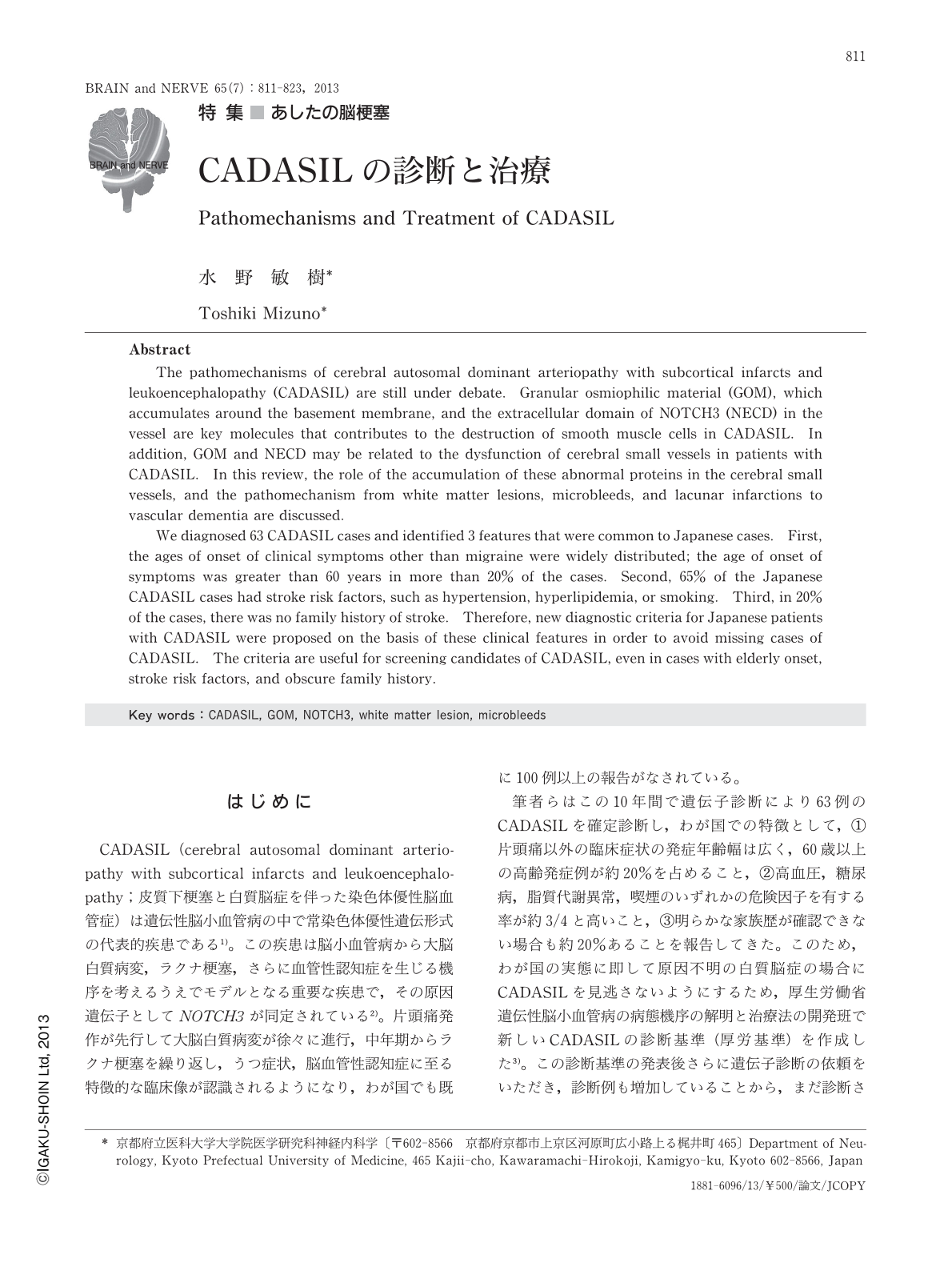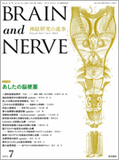Japanese
English
- 有料閲覧
- Abstract 文献概要
- 1ページ目 Look Inside
- 参考文献 Reference
はじめに
CADASIL(cerebral autosomal dominant arteriopathy with subcortical infarcts and leukoencephalopathy;皮質下梗塞と白質脳症を伴った染色体優性脳血管症)は遺伝性脳小血管病の中で常染色体優性遺伝形式の代表的疾患である1)。この疾患は脳小血管病から大脳白質病変,ラクナ梗塞,さらに血管性認知症を生じる機序を考えるうえでモデルとなる重要な疾患で,その原因遺伝子としてNOTCH3が同定されている2)。片頭痛発作が先行して大脳白質病変が徐々に進行,中年期からラクナ梗塞を繰り返し,うつ症状,脳血管性認知症に至る特徴的な臨床像が認識されるようになり,わが国でも既に100例以上の報告がなされている。
筆者らはこの10年間で遺伝子診断により63例のCADASILを確定診断し,わが国での特徴として,①片頭痛以外の臨床症状の発症年齢幅は広く,60歳以上の高齢発症例が約20%を占めること,②高血圧,糖尿病,脂質代謝異常,喫煙のいずれかの危険因子を有する率が約3/4と高いこと,③明らかな家族歴が確認できない場合も約20%あることを報告してきた。このため,わが国の実態に即して原因不明の白質脳症の場合にCADASILを見逃さないようにするため,厚生労働省遺伝性脳小血管病の病態機序の解明と治療法の開発班で新しいCADASILの診断基準(厚労基準)を作成した3)。この診断基準の発表後さらに遺伝子診断の依頼をいただき,診断例も増加していることから,まだ診断されていない症例・家系があるのではないかと予想される。
本特集では血管病変への沈着性障害が1つのテーマとなっているが,脳アミロイド血管症(cerebral amyloid angiopathy:CAA)では血管へアミロイド沈着を生じ易出血性を特徴とするのに対して,CADASILでは電子顕微鏡で認めるgranular osmiophilic material(GOM)の血管平滑筋細胞基底膜周囲への沈着と,NOTCH3細胞外ドメイン(notch extracellular domain:NECD)が血管に蓄積する点が4),異常蛋白の蓄積という病態を考えるうえで重要である。本年,CADSILの発症機序について重要な報告がされている。GOMはCADASILの疾患概念が提唱された当初から認められた特異的な所見にもかかわらず5),その構成成分としてNECDを含むか含まないかについては議論が続いていたが5,6),NECDが主要成分であることを示す結果が報告された7)。続いて変異型NECDにより機能的にも重要である細胞外基質tissue inhibitor of metalloproteinases3(TIMP3)とビトロネクチン(VTN)が誘導されて凝集に関わり,CADSAILの病態に重要であることが報告された8)。これらの結果はCADASILの発症機序について2つの大きな示唆を与えている。第1は異常蛋白の蓄積がNOTCH3変異によるgain of toxic functionとしてCADASIL発症へ関与する点,第2はNECDやGOMの沈着がCADASILで認められる血管反応性障害に関与する点である。
本稿ではCADASILの特徴,厚生労働省研究班で作成した診断基準を紹介するとともに,発症機序,小血管病により白質病変,梗塞,認知症発症への進展,治療の問題点について概説する。
Abstract
The pathomechanisms of cerebral autosomal dominant arteriopathy with subcortical infarcts and leukoencephalopathy (CADASIL) are still under debate. Granular osmiophilic material (GOM), which accumulates around the basement membrane, and the extracellular domain of NOTCH3 (NECD) in the vessel are key molecules that contributes to the destruction of smooth muscle cells in CADASIL. In addition, GOM and NECD may be related to the dysfunction of cerebral small vessels in patients with CADASIL. In this review, the role of the accumulation of these abnormal proteins in the cerebral small vessels, and the pathomechanism from white matter lesions, microbleeds, and lacunar infarctions to vascular dementia are discussed.
We diagnosed 63 CADASIL cases and identified 3 features that were common to Japanese cases. First, the ages of onset of clinical symptoms other than migraine were widely distributed; the age of onset of symptoms was greater than 60 years in more than 20% of the cases. Second, 65% of the Japanese CADASIL cases had stroke risk factors, such as hypertension, hyperlipidemia, or smoking. Third, in 20% of the cases, there was no family history of stroke. Therefore, new diagnostic criteria for Japanese patients with CADASIL were proposed on the basis of these clinical features in order to avoid missing cases of CADASIL. The criteria are useful for screening candidates of CADASIL, even in cases with elderly onset, stroke risk factors, and obscure family history.

Copyright © 2013, Igaku-Shoin Ltd. All rights reserved.


